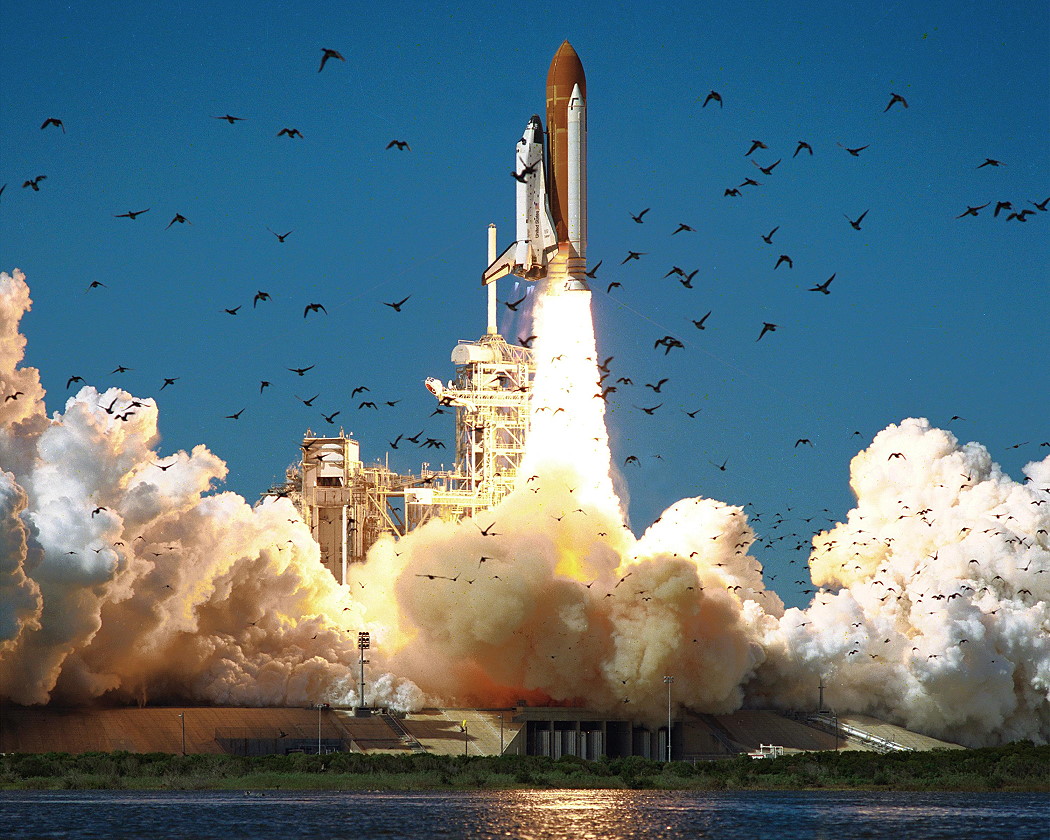
On this day in 1986, the sight of shuttle Challenger exploding in the skies above Cape Canaveral painted an indelible mark on the public psyche and still carries the power to haunt. Over the minutes, hours, days, weeks, months and years to come, the loss of the shuttle and her seven-member crew—Commander Dick Scobee, Pilot Mike Smith, Mission Specialists Ellison Onizuka, Judy Resnik and Ron McNair and Payload Specialists Greg Jarvis and Christa McAuliffe—would be played out again and again via television and later the internet. An innocence, veteran astronaut Robert “Hoot” Gibson reflected, was lost on 28 January 1986 and the ramifications of the tragedy entirely reshaped the next quarter-century of the shuttle program. Never again would this inherently dangerous machine be considered truly “safe”.
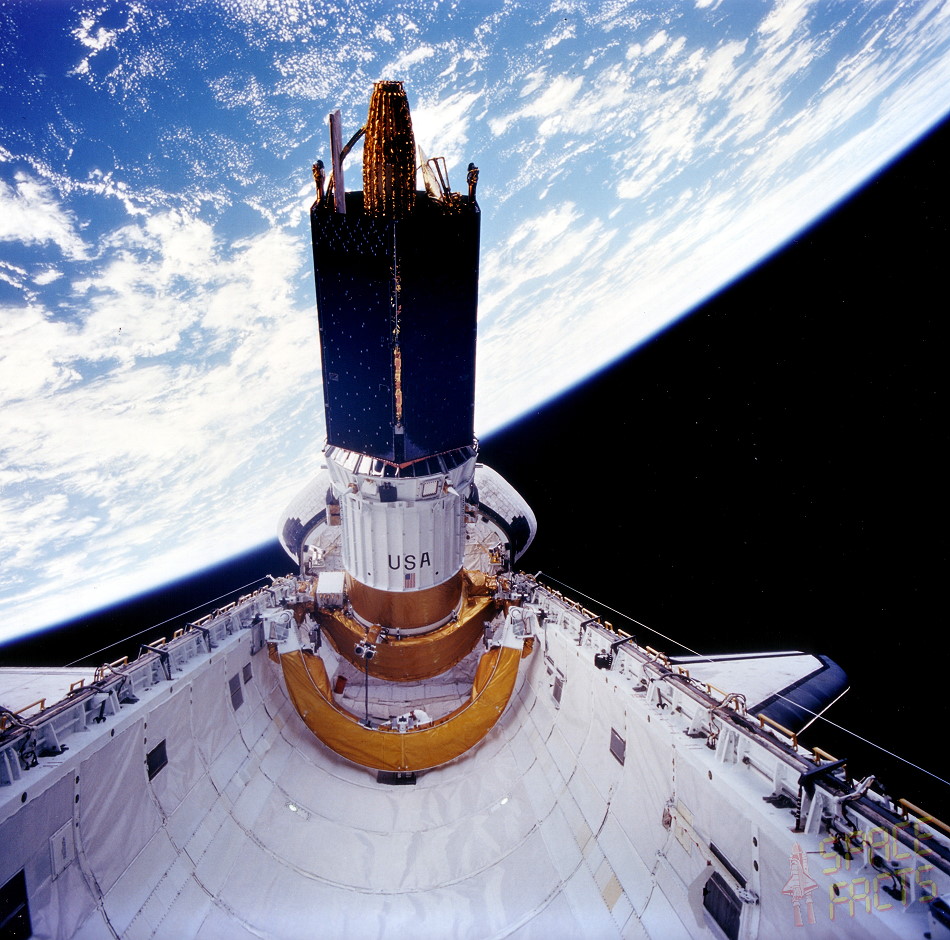
Mission 51L, Challenger’s final flight, was tasked with deploying NASA’s second Tracking and Data Relay Satellite (TDRS-B) and the Spartan-203 free-flyer to observe Halley’s Comet. The six-day mission would also feature social studies schoolteacher McAuliffe as the first private citizen to fly into space. Picked from thousands of applicants for the “Teacher in Space” initiative in July 1985, she was to teach two lessons from aboard Challenger, providing a publicity boost for NASA as it sought to demonstrate that its reusable fleet of orbiters were operational and convince senior politicians to support a permanent space station. Years later, McAuliffe’s mother, Grace Corrigan, would insist that the general atmosphere in the weeks leading up to Challenger’s fateful launch was that the shuttle was far safer than an airliner, simply due to the higher number of precautions taken by NASA.
Her training at the Johnson Space Center (JSC) in Houston, Texas, began in September 1985, and by the time the 51L crew arrived at the Kennedy Space Center (KSC) in Florida in January 1986, their launch had already been postponed by delays in bringing Columbia home from its 61C mission and weather concerns at a Transoceanic Abort Landing site in Senegal. More trouble was afoot. Predictions of unacceptable weather in Florida put paid to a second attempt on the 26th, and, when Scobee and his crew settled into their seats aboard Challenger on the 27th, they were again thwarted by high winds and a frozen handle on the hatch.
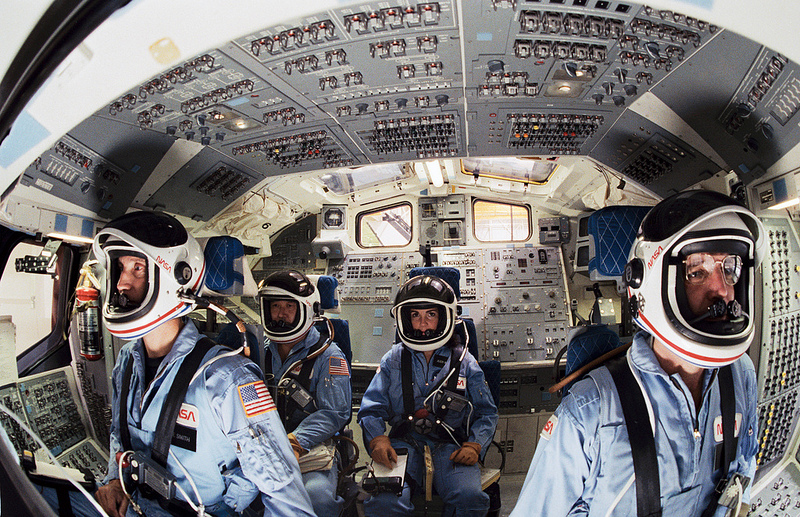
In the years that followed, many observers commented that launching on Super Bowl Sunday, the 26th, might well have saved 51L. “It’s another case of fate, playing tricks on you,” remembered former NASA Administrator Jim Beggs in an oral history. “They decided not to launch on Super Bowl Sunday, but Super Bowl Sunday was a fine day. If they’d have launched then, they wouldn’t have had any trouble, so they held it over and caught the cold spell and lost the vehicle and the crew.” On the night of Monday 27th, temperatures at the launch site plummeted, precipitously, to an unseasonal -13 degrees Celsius (8.6 degrees Fahrenheit), forcing technicians to switch on safety showers and fire hoses at Pad 39B to prevent water pipes from freezing. This proved particularly worrisome for the ice inspection team, who began their final “sweep-down” of the pad area in the early hours of the 28th, and they were obliged to knock a large number of 12-inch (30-cm) icicles away with broom handles as the countdown clock continued ticking toward launch.
Next morning, the Sun rose on the coldest weather conditions under which a shuttle launch had ever been attempted, a fact that would be investigated in depth during the subsequent presidential inquiry into the cause of the tragic events later that day. The copious amounts of ice on Pad 39B forced an additional two-hour delay to permit thawing. Nonetheless, many of the astronauts’ families, including Scobee’s wife, June, doubted that NASA would fly in such conditions. She was partially appeased by her husband’s insistence, over the phone that morning, that he felt it was safe to do so.
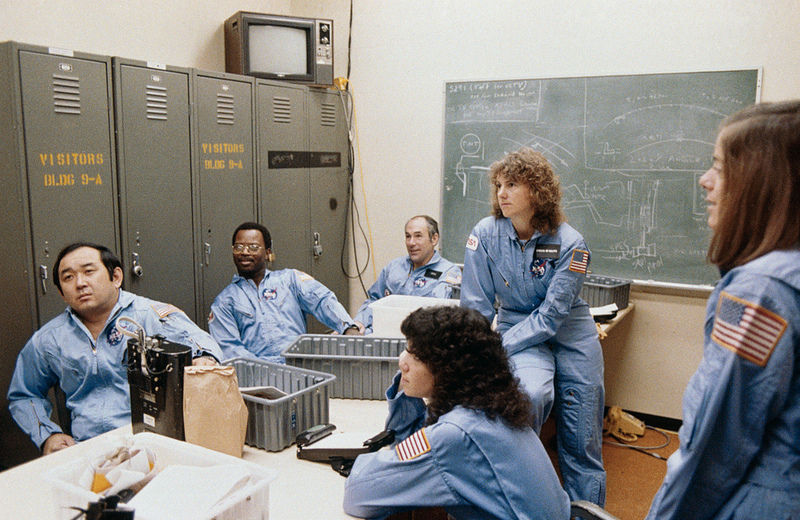
Launch occurred at precisely 11:38 a.m. EST. Six and a half seconds before liftoff, Challenger’s three main engines thundered to life and, as the countdown clock touched zero, the assembled spectators at KSC were greeted by the ear-splitting staccato crackle of her twin Solid Rocket Boosters (SRBs). It proved to be the failure of both primary and secondary O-ring seals at the base of the right hand booster, investigators would later conclude from photographic, physical, and other evidence, that was directly and solely responsible for the destruction of 51L and the loss of her crew.
Clear evidence of the boosters’ fallibility, made public for the first time by the Rogers report, occurred serendipitously when, 0.678 seconds after liftoff, a video camera mounted close to Pad 39B captured “a strong puff of grey smoke…spurting from the vicinity of the aft field joint of the right Solid Rocket Booster.” The camera had identified the tell-tale result of both the primary and secondary O-rings—which were meant to stop searing gases from escaping between the joints of the booster segments—failing, disintegrating, and streaming away in the moments after ignition. More significantly, the point of failure directly faced the External Tank and its volatile liquid oxygen and hydrogen propellants. Any flame from the compromised booster could now play on the tank like a blowtorch, igniting its contents in a fireball and destroying Challenger, together with the entire launch complex. Years later, Morton Thiokol structural engineer Roger Boisjoly would express astonishment that the vehicle did not explode on the pad; by an incredible sequence of events, a chunk of solid fuel temporarily plugged the O-ring hole, and the first minute of ascent proceeded normally.
The temporary plug, however, was just that: temporary. It would not hold.
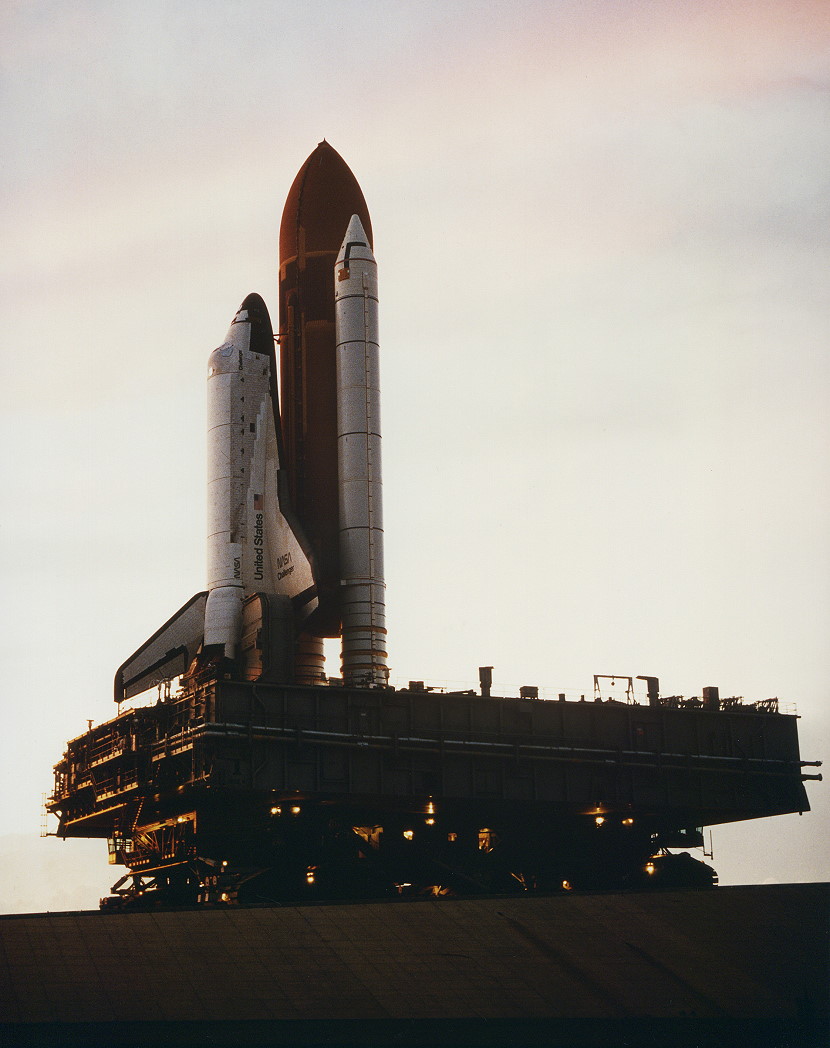
Several more puffs of increasingly denser, darker smoke—further indicative that the products under combustion were indeed the grease, insulation, and rubberized O-ring material from the joint seals—were recorded by other ground-level cameras between 0.836 and 2.5 seconds after liftoff, as the boosters’ hold-down posts were severed and the shuttle commenced its climb-out from Pad 39B. As each puff was left behind by Challenger’s upward trajectory, the next fresh puff could be seen close to the level of the joint. The frequency of these emissions was directly related to flexure within the structure of the SRB as the gap in its joint cycled open and closed. The last incidence of smoke above the joint was timed at T+2.733 seconds. In the milliseconds that followed, a combination of atmospheric factors and exhaust from the boosters made it difficult to determine if any more smoke was emerging from the failure point.
A little under eight seconds into the mission, as planned, the vehicle cleared the tower and began a programmed roll maneuver, moving onto the correct flight azimuth for a 28.45-degree orbit, then pitching onto her back under the control of her computers. Shortly thereafter, at T+19 seconds, to prepare herself for passage through a period of maximum aerodynamic turbulence (known as “Max Q”), Challenger’s main engines were throttled down from 104 to 94 percent, and later 65 percent, of rated thrust. Thirty-seven seconds into the ascent, she encountered the first of several high altitude wind shears, lasting until just past a minute after launch. In its inquiry, the Rogers Commission report noted that the shuttle’s guidance, navigation, and control system immediately detected and compensated for these conditions, and—although 51L’s aerodynamic loads were higher than previous missions in both the yaw and pitch planes—the SRBs, too, responded effectively to all commands.
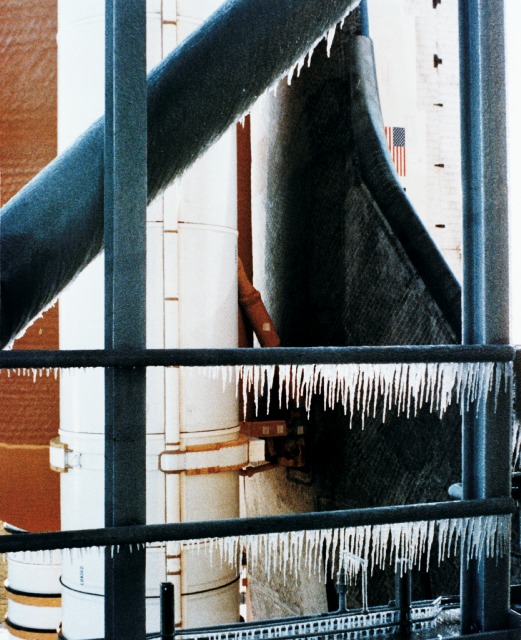
It is possible that the mission may still have proceeded normally, had the plug of solid fuel remained jammed into the O-ring breach. However, by an incredible stroke of cruel luck, Challenger happened to pass through the most severe wind shear ever encountered by an ascending shuttle stack. The shear dislodged the plug around a minute into the mission. After passing through maximum aerodynamic turbulence, 51 seconds into the climb, her main engines were throttled back up to full power; shortly afterward, at 58.788 seconds, a frame of video recorded the first evidence of a flickering flame from the right-hand SRB’s aft joint. The temporary plug of solid fuel had gone, and, although they were oblivious to anything amiss, the crew’s fate was now sealed.
The flame rapidly established itself, growing into a well-defined plume within half a second. Exactly a minute into the mission, downlinked telemetry pointed to an unusual chamber pressure differential between the left and right boosters—the pressure of the latter was some 11.8 psi (81.3 kPal) lower than the other, indicating a leak in its aft joint. As the flame increased in size, Challenger’s aerodynamic “slipstream” deflected it backward and circumferentially by the protruding structure of the upper ring which linked the SRB to the External Tank, focusing the flame directly onto the surface of the tank. Sixty-two seconds into the ascent, the left booster’s thrust vector control moved to compensate for the yaw motion caused by the reduced thrust from its right-side counterpart. A couple of seconds later came the first visual manifestation that the flame from the damaged booster had breached the lower segment of the External Tank: an abrupt change in the shape and color of the flame, indicating that it was now mixing with leaking liquid hydrogen. Moreover, pressurization data at around this point reinforced the fact that its liquid hydrogen tank was indeed ruptured.
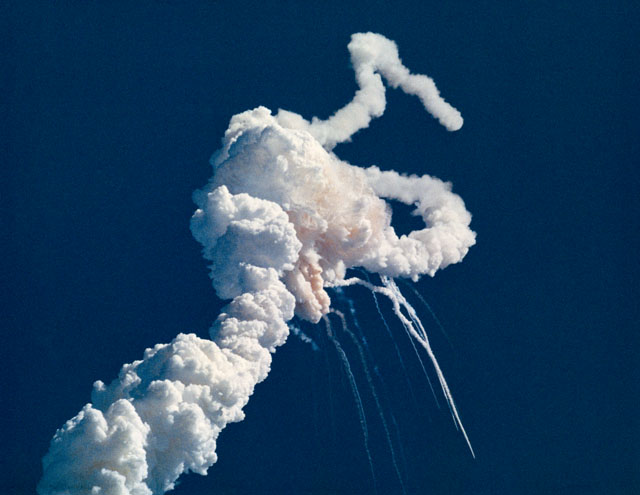
In Mission Control, astronaut Dick Covey—sitting alongside fellow astronaut Fred Gregory at the Capcom’s console—relayed a standard call: “Challenger, Go at throttle up.” Commander Dick Scobee came back a second or two later. “Roger,” he replied. “Go at throttle up.”
In the seconds that followed, an incredibly rapid sequence of events concluded with the destruction of the External Tank, the separation of both boosters, and the structural disintegration of Challenger. Seventy-two seconds after liftoff, the flame from the right SRB finally burned through the lower of two struts holding it onto the External Tank; pivoting around its upper strut, the top of the booster impacted the inter-tank and the base of the liquid oxygen tank, breaching them both. Nearly simultaneously, around T+73.1 seconds, clouds of white vapor were spotted at the top of the tank and around the area of its bottom dome: the former was clearly indicative of the ruptured liquid oxygen tank, the latter conclusive evidence of structural failure. Almost immediately, at T+73.6 seconds, came a massive—“almost explosive,” read the Rogers report—burning of both the hydrogen leaking from the lowermost tank and the oxygen from its uppermost section.
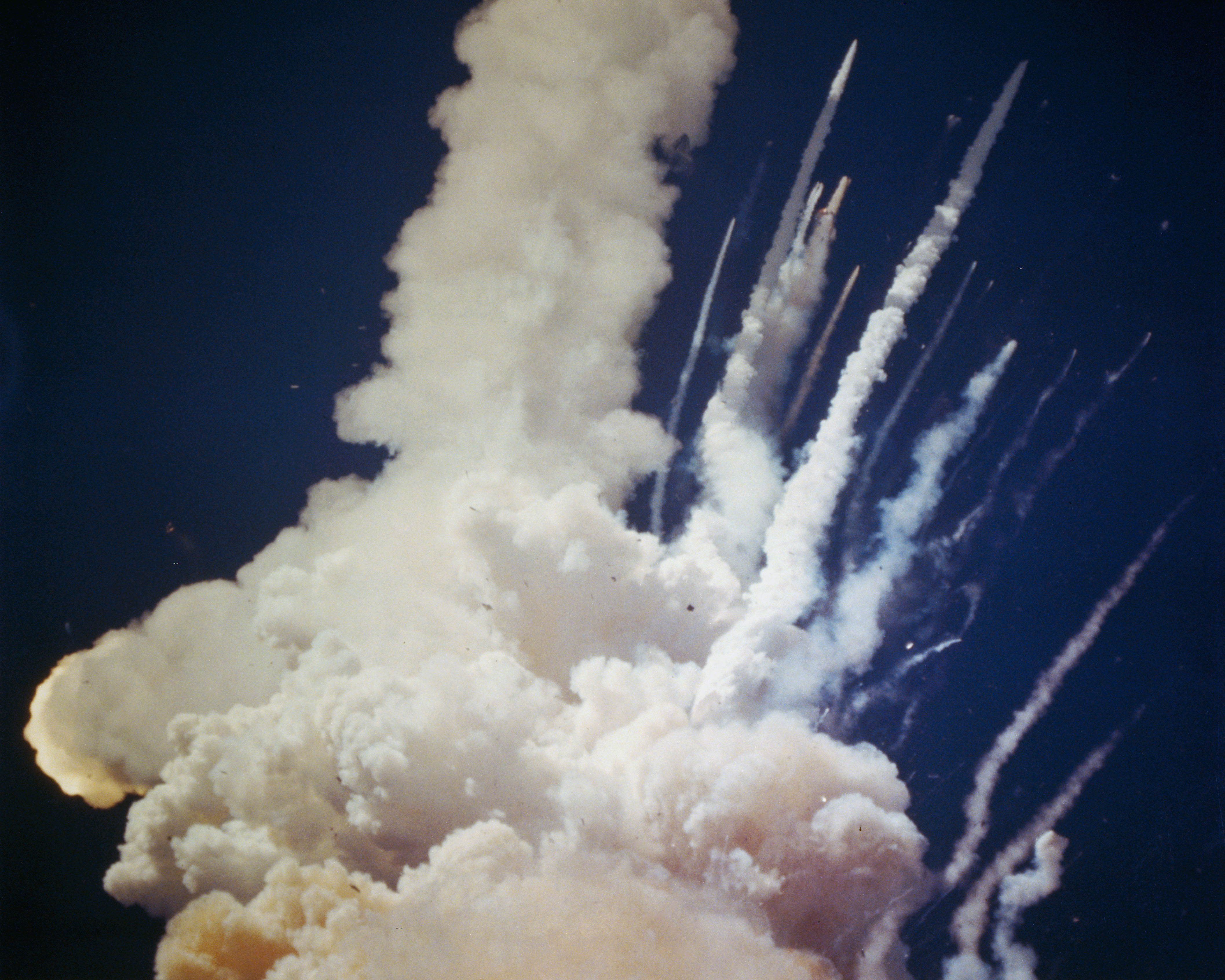
At this point, 51L was at an altitude of nine miles (15 km) over the Atlantic Ocean, traveling at almost twice the speed of sound, and Challenger was lost from view in the resultant explosive burn. Her Reaction Control System (RCS) ruptured during this period, setting off the hypergolic burning of its propellants, evidenced by a reddish-brown hue around the edge of the fireball. Meanwhile, the two boosters, now released of their loads, rapidly climbed away from the catastrophe, but were remotely destroyed by the Range Safety Officer at 11:39:50 a.m. EST, some 110 seconds after launch. “Obviously a major malfunction,” was all Steve Nesbitt, the stunned launch commentator, could remark.
Now subjected to aerodynamic loads for which she had not been designed, Challenger had disintegrated into several large fragments. Clearly visible, tumbling away from the blossoming cloud of debris that had swallowed the External Tank, were her aft compartment—with main engines, briefly, still firing—together with one wing and a fuzzy, roughly triangular blob: the forward fuselage, containing the crew cabin, trailing a jumble of umbilical lines ripped from beneath the payload bay floor. It continued, for a time, on an upward trajectory on a ballistic arc that reached a maximum altitude of around 11 miles (18 km), before gravity inexorably pulled it down at close to 250 mph (400 km/h), toward an Atlantic grave.
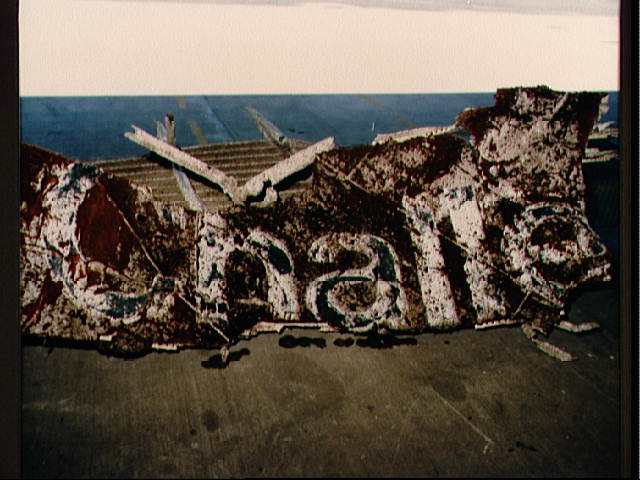
The loss of Challenger, played out as it was in the most devastatingly public fashion, would bring the shuttle program and NASA to its knees for far longer than the 32 months needed to return the reusable vehicles to flight. Investigators would uncover a range of technical, managerial, and other human factors behind the tragedy, and in September 1988 a safer—though still intrinsically unsafe—shuttle would return to flight.
And with each and every launch that followed, right up to the very end of the shuttle’s 30-year history, the launch phase remained arguably the most critical. For each mission, the 73-second psychological barrier was a powerful hurdle for each crew to overcome. Even as Atlantis rocketed aloft for the shuttle program’s finale on 8 July 2011, many hearts still missed a beat as STS-135 Commander Chris Ferguson called “Roger, Go at throttle up.”




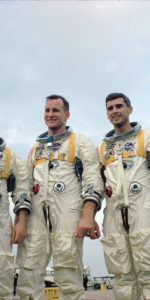
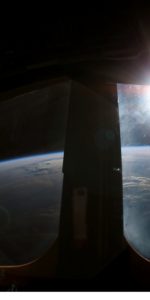
“On this day in 1986, the sight of shuttle Challenger exploding in the skies above Cape Canaveral”
Challenger did not “explode”. Structural disintegration of the External Tank after RH SRB detached and rotated into the tank. The “explosion”
was the cryogenic fuels combusting in a violent burn after being dispersed from the breeched ET at supersonic speeds. Still a disaster and
a sorrowful tragedy. God Speed Challenger…..
Hello Bill,
The article does make reference later to the “almost explosive” burning (as quoted by the Rogers Commission) of the propellants during the structural breakup. However, to onlookers at the Cape, the “sight” appeared to be an explosion, so the use of the word “explosion” was intended more a figure of speech that a strictly technical point.
Thank you for your comment.
Best wishes,
Ben
More than three decades after Challenger, the International Space Station is the legacy of the shuttle program. It is also what many of the astronauts who died on Challenger (and Columbia) strove for. A fitting and living memorial that continues as NASA prepares to launch U.S. astronauts from U.S. soil, once again.